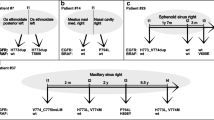Abstract
Background
The mechanism underlying the malignant transformation of inverted papilloma (IP) has not yet been elucidated.
Methods
To clarify the genes responsible for the malignant transformation, we analyzed 10 cases of IP, 8 of IP with dysplasia, and 11 of squamous cell carcinoma (SCC) by targeted amplicon sequencing.
Results
The number of mutant genes increased in the order of IP < dysplasia < SCC. Significant differences were observed in the mutation rates of three genes (KRAS, APC and STK11) in particular. TP53 was altered frequently in each group and might be involved in malignant transformation based on to the site of the mutation. A comparison of the genetic variants by region of IP tissue among patients with IP alone, and those with dysplasia or SCC revealed significant differences in the mutation rate of the KRAS gene.
Conclusion
Identification of genetic mutations in KRAS is effective for predicting the malignant transformation of IP.







Similar content being viewed by others
References
Batsakis JG, Suarez P (2001) Schneiderian papillomas and carcinomas: a review. Adv Anat Pathol 8:53–64
Buchwald C, Franzmann MB, Tos M (1995) Sinonasal papillomas: a report of 82 cases in Copenhagen County, including a longitudinal epidemiological and clinical study. Laryngoscope 105:72–79
Re M, Zizzi A, Ferrante L et al (2014) p63 and Ki-67 immunostainings in laryngeal squamous cell carcinoma are related to survival. Eur Arch Otorhinolaryngol 271:1641–1651
Lawson W, Kaufman MR, Biller HF (2003) Treatment outcomes in the management of inverted papilloma: an analysis of 160 cases. Laryngoscope 113:1548–1556
Schlosser RJ, Mason JC, Gross CW (2001) Aggressive endoscopic resection of inverted papilloma: an update. Otolaryngol Head Neck Surg 25:49–53
Sanderson RJ, Knegt PK (1999) Management of inverted papilloma via Denker’s approach. Clin Otolaryngol 24:69–71
Deitmer T, Wiener C (1996) Is there an occupational etiology of inverted papilloma of the nose and sinuses? Acta Otolaryngol 116:762–765
Davey JW, Hohenlohe PA, Etter PD et al (2011) Genome-wide genetic marker discovery and genotyping using next-generation sequencing. Nat Rev Genet 12:499–510
Coco S, Truini A, Vanni I et al (2015) Next generation sequencing in non-small cell lung cancer: new avenues toward the personalized medicine. Curr Drug Targets 16:47–59
The Cancer Genome Atlas Network (2015) Comprehensive genomic characterization of head and neck squamous cell carcinomas. Nature 517:576–582
Lee GH, Yoon YH, Kim YM et al (2012) Pattern of expression of cyclooxygenase-2 in malignant transformation of sinonasal inverted papilloma. Am J Otolaryngol 33(5):585–589
Yamashita Y, Hasegawa M, Deng Z et al (2015) Human papillomavirus infection and immunohistochemical expression of cell cycle proteins pRb, p53, and p16(INK4a) in sinonasal diseases. Infect Agent Cancer 10:23
Zhao RW, Guo ZQ, Zhang RX (2016) Human papillomavirus infection and the malignant transformation of sinonasal inverted papilloma: a meta-analysis. J Clin Virol 79:36–43
Huang CC, Lee TJ, Chang PH et al (2010) Desmoglein 3 is overexpressed in inverted papilloma and squamous cell carcinoma of sinonasal cavity. Laryngoscope 120:26–29
Koo BS, Jung BJ, Kim SG, et al. (2011) Altered expression of E-cadherin and β-catenin in malignant transformation of sinonasal inverted papillomas. Rhinology 49:479–485
Lin GC, Scheel A, Akkina S et al (2013) Epidermal growth factor receptor, p16, cyclin D1, and p53 staining patterns for inverted papilloma. Int Forum Allergy Rhinol 3:885–889
Oncel S, Cosgul T, Calli A et al (2011) Evaluation of p53, p63, p21, p27, ki-67 in paranasal sinus squamous cell carcinoma and inverted papilloma. Indian J Otolaryngol Head Neck Surg 63:172–177
Tsou YA, Huang HJ, Wang TC et al (2014) Evaluation of correlation of cell cycle proteins and Ki-67 interaction in paranasal sinus inverted papilloma prognosis and squamous cell carcinoma transformation. Biomed Res Int 2014:634945
Wu HH, Zafar S, Huan Y et al (2009) Fascin over expression is associated with dysplastic changes in sinonasal inverted papillomas: a study of 47 cases. Head Neck Pathol 3:212–216
Udager AM, Rolland DCM, McHugh JB et al (2015) High-frequency targetable EGFR mutations in sinonasal squamous cell carcinomas arising from inverted sinonasal papilloma. Cancer Res 75:2600–2606
Udager AM, McHugh JB, Betz BL et al (2016) Activating KRAS mutations are characteristic of oncocytic sinonasal papilloma and associated sinonasal squamous cell carcinoma. J Pathol 239:394–398
Author information
Authors and Affiliations
Corresponding author
Ethics declarations
Conflict of interest
No author has any conflict of interest.
About this article
Cite this article
Yasukawa, S., Kano, S., Hatakeyama, H. et al. Genetic mutation analysis of the malignant transformation of sinonasal inverted papilloma by targeted amplicon sequencing. Int J Clin Oncol 23, 835–843 (2018). https://doi.org/10.1007/s10147-018-1296-1
Received:
Accepted:
Published:
Issue Date:
DOI: https://doi.org/10.1007/s10147-018-1296-1




